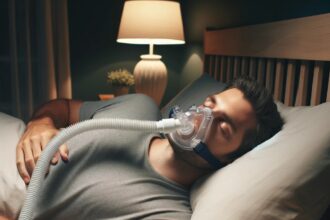For many people with sleep apnea, the introduction of Continuous Positive Airway Pressure (CPAP) therapy is a game-changer. CPAP machines help keep airways open during sleep, preventing the interruptions in breathing that characterize sleep apnea. However, while CPAP treatment is highly effective, some users report experiencing headaches after starting therapy. This connection between CPAP use and headaches can be troubling, especially for individuals already dealing with the challenges of sleep apnea. Understanding the reasons behind these headaches and how to address them is crucial for ensuring effective and comfortable treatment.
At Mass Tort America, we understand that health complications arising from medical treatments can be frustrating and confusing. We aim to provide clarity and support for those dealing with such issues, especially when they impact something as vital as sleep. If you’re experiencing headaches related to CPAP use, you may need more information about your situation and possibly legal assistance. Our team is here to help you navigate these concerns and find the best path forward.
How CPAP Use Can Lead To Headaches
CPAP-related headaches can occur for various reasons, each requiring a different approach to resolve. One of the most common causes is sinus pressure. CPAP machines deliver a continuous flow of air into the nasal passages, which can sometimes lead to increased pressure in the sinuses, especially if the machine is not adjusted correctly. This increased pressure can manifest as a headache, particularly around the forehead and behind the eyes. For some users, adjusting the humidity settings or using a heated hose can alleviate this issue by reducing the drying effect of the air and helping the sinuses remain clear.
Another potential cause of headaches in CPAP users is mask fit. If the CPAP mask is too tight or does not fit properly, it can exert pressure on the face, particularly around the forehead and temples, leading to tension headaches. In addition, an ill-fitting mask may cause air leaks, which can make the machine work harder to maintain pressure, potentially worsening the problem. Ensuring that the mask fits snugly but comfortably is essential to prevent these issues. Users may need to try different mask styles or sizes to find the one that works best for them.
A third factor to consider is the possibility of changes in carbon dioxide levels. CPAP therapy primarily addresses low oxygen levels during sleep apnea episodes, but it can also affect the balance of gases in the bloodstream. In some cases, CPAP use may lead to a decrease in carbon dioxide levels, which can trigger headaches. This issue is less than one common cause, but can be particularly concerning, as it may indicate that the CPAP settings need to be adjusted by a healthcare provider. Monitoring symptoms and consulting with a medical professional is essential if this cause is suspected.
Preventive Measures And Solutions
Addressing CPAP-related headaches involves identifying the underlying cause and taking steps to prevent further occurrences. For those experiencing sinus-related cluster headaches often, adjusting the machine’s humidity settings is a simple yet often effective solution. Increasing the humidity can help keep the nasal passages moist, reducing the likelihood of sinus congestion and the associated headaches. Additionally, using a saline nasal spray before bedtime can further alleviate dryness and prevent sinus issues.
For headaches caused by mask fit, it may be necessary to experiment with different types of masks. CPAP masks come in various styles, including nasal masks, full-face masks, and nasal pillows, each offering different benefits depending on the user’s needs. Finding a mask that fits well without being too tight is crucial. Some users find that using mask liners or padding can help reduce pressure points and improve comfort, thereby reducing the likelihood of tension headaches.
If carbon dioxide imbalance is suspected, it’s vital to consult with a healthcare provider who can evaluate the the CPAP pressure and machine’s settings and make necessary adjustments. This might involve changing the pressure settings or even considering alternative treatments if CPAP therapy is not providing the desired results. Regular follow-up appointments and communication with a healthcare provider can help ensure that CPAP therapy remains effective and comfortable without causing additional health issues.
Understanding CPAP Therapy: The Basics
CPAP therapy, or Continuous Positive Airway Pressure therapy, is a standard treatment for obstructive sleep apnea (OSA), a condition where the airway collapses during sleep, leading to breathing interruptions. CPAP machines work by delivering a continuous stream of air through a mask, which keeps the airway open and prevents apnea episodes. This treatment is highly effective for most patients and can significantly improve sleep quality and overall health.
While CPAP therapy is beneficial, it requires consistent use and proper management to be effective. Patients must understand how their machine works, how to adjust settings, and how to maintain the equipment to ensure its optimal functioning. This basic knowledge is crucial for achieving the best results from CPAP therapy and minimizing potential side effects, such as headaches.
The Role Of Humidity In CPAP Therapy
Humidity plays a significant role in the comfort and effectiveness of CPAP therapy. The air delivered by a CPAP machine can be quite dry, especially when used at higher pressures. This dryness can lead to irritation of the nasal passages and sinuses, which in turn can cause headaches. Many CPAP machines come equipped with a humidifier to address this issue, allowing users to adjust the humidity level to suit their needs.
Using a heated humidifier can help reduce the dryness of the air and prevent sinus-related headaches. Additionally, some patients find that using a heated hose further improves comfort by ensuring that the air reaching their nose and throat is at a comfortable temperature. Adjusting humidity settings and using the right accessories can significantly enhance the CPAP experience and reduce the likelihood of headaches.
Mask Fit And Its Impact On CPAP Therapy
The fit of a CPAP mask is crucial for both comfort and effectiveness. An improperly fitted mask can cause air leaks, reduce the effectiveness of the therapy, and lead to discomfort or headaches. Masks that are too tight may exert pressure on the face, leading to tension headaches, while masks that are too loose may cause air to escape, resulting in poor therapy outcomes and disrupted sleep.
There are various types of CPAP masks, including nasal masks, full-face masks, and nasal pillows. Finding the right fit may require trying different styles and sizes. It is essential to work with a healthcare provider or CPAP specialist to find the most suitable mask, ensuring a secure fit that is comfortable and effective in delivering therapy.
Addressing Sinus Pressure In CPAP Users
Sinus pressure is a common issue for CPAP users and can be a significant cause of headaches. The continuous flow of air into the nasal passages can sometimes cause an imbalance in sinus pressure, leading to discomfort experience headaches, and pain. This is especially true if the sinuses are already inflamed due to allergies, colds, or other conditions.
To mitigate sinus pressure, users can adjust their CPAP machine’s settings, such as lowering the air pressure or increasing the humidity. Additionally, using a saline nasal spray before bed can help keep the nasal passages clear and reduce the risk of sinus headaches. In cases where sinus pressure persists, consulting with a healthcare provider is recommended to explore other potential solutions.
The Impact Of CPAP Therapy On Sleep Quality
CPAP therapy is designed to improve sleep quality by preventing apnea episodes, but in some cases, it can lead to other serious sleep disorders or disturbances, such as headaches. For example, if a CPAP machine is not properly adjusted, it can cause discomfort that leads to restless sleep and morning headaches. Additionally, some users may experience disruptions due to noise from the machine or mask discomfort, both of which can affect sleep quality.
Improving sleep quality involves not only optimizing CPAP settings but also ensuring a comfortable sleeping environment. This may include using earplugs to block out noise, adjusting bedding to improve comfort, and maintaining a regular sleep schedule. These strategies, combined with effective CPAP therapy, can help users achieve better sleep and reduce the occurrence of headaches.
The Connection Between CPAP Therapy And Blood Pressure
CPAP therapy can have a positive impact on blood pressure, particularly in individuals with obstructive sleep apnea. Sleep apnea is associated with increased cardiovascular risk, including hypertension. By preventing and treating sleep apnea episodes, CPAP therapy helps stabilize breathing and oxygen levels, which can lead to lower blood pressure.
However, some users may experience a temporary increase in blood pressure when starting CPAP therapy, which can contribute to headaches. This is often due to the body adjusting to the new treatment. Monitoring blood pressure regularly and consulting with a healthcare provider can help manage these changes and ensure that CPAP therapy is beneficial for overall cardiovascular health.
Carbon Dioxide Imbalance: A Lesser-Known Cause Of Headaches
While oxygen levels are often the focus of CPAP therapy, carbon dioxide (CO2) levels also play a critical role in respiratory health. In some cases, CPAP therapy can cause a decrease in CO2 levels, leading to a condition known as hypocapnia. Hypocapnia can trigger headaches, dizziness, and other symptoms, particularly if the CPAP machine is set to deliver excessive air pressure.
Addressing CO2 imbalance involves fine-tuning the CPAP machine’s settings to ensure that it provides the right amount of air pressure without disrupting the natural balance of gases in the bloodstream. If CO2 imbalance is suspected, a healthcare provider can perform tests to evaluate gas exchange and recommend appropriate adjustments to the therapy.
Managing Dry Mouth And Its Role In Headaches
Dry mouth is a common side effect of CPAP therapy, especially in individuals who use a full-face mask or tend to breathe through their mouth during sleep. Dry mouth can lead to dehydration, which in turn can cause headaches, particularly in the morning. Addressing dry mouth involves ensuring that the CPAP mask fits properly to prevent air leaks and considering the use of a chin strap to keep the mouth closed during sleep.
Additionally, increasing the humidity setting on the CPAP machine can help alleviate dry mouth by adding moisture to the air. Staying hydrated throughout the day and using a humidifier in the bedroom can also help prevent dry mouth and reduce the risk of associated headaches.
Understanding Pressure Settings In CPAP Therapy
The pressure settings on a CPAP machine are crucial for effective therapy. Too high a pressure setting can lead to discomfort, air leaks, and headaches, while too low a pressure setting may not provide sufficient therapy, allowing apnea episodes to continue. Finding the optimal pressure setting requires a balance between effectiveness and comfort.
Most CPAP machines come with an automatic pressure adjustment feature, which can help tailor the therapy to the user’s needs throughout the night. However, some users may require manual adjustments based on their specific condition and comfort level. Regular follow-ups with a healthcare provider can ensure that the pressure settings are optimized for both efficacy and comfort, reducing the likelihood of headaches.
Allergies And CPAP Therapy: What You Need To Know
Allergies can complicate CPAP therapy, particularly if nasal congestion is an issue. Congestion can increase the resistance to airflow, making it harder for the CPAP machine to maintain the necessary pressure. This can lead to discomfort, poor sleep quality, and headaches. Additionally, allergens such as dust mites or pet dander can accumulate in the CPAP machine or mask, further exacerbating symptoms.
To manage allergies while using CPAP, it’s essential to clean the machine and mask regularly to remove allergens. Using hypoallergenic bedding and keeping the sleeping environment clean can also help reduce exposure to allergens. For those with severe allergies, using a nasal spray or taking allergy medication may be necessary to ensure that CPAP therapy remains effective and comfortable.
The Role Of CPAP Machines In Preventing Migraines
Migraines are a severe form of headache that can be triggered by various factors, including sleep disturbances. For individuals with sleep apnea who also suffer from migraines, CPAP therapy can be an essential part of managing both conditions. By improving sleep quality and reducing apnea episodes, CPAP therapy can help prevent migraines and chronic headache that are triggered by poor sleep.
However, if the CPAP machine itself is causing discomfort or headaches, it’s crucial to address these issues promptly to avoid exacerbating migraines. Adjusting the pressure settings, ensuring a proper mask fit, and using appropriate accessories such as a heated humidifier can help prevent CPAP-related discomfort and reduce the risk of triggering migraines.
CPAP Compliance: Why It Matters For Headache Prevention
CPAP compliance refers to how consistently and correctly a patient uses their CPAP machine. Non-compliance, or not using the machine as prescribed, can lead to a recurrence of sleep apnea symptoms, including daytime fatigue and headaches. It can also reduce the overall effectiveness of the therapy, making it harder to achieve the desired health outcomes.
Ensuring CPAP compliance involves regular use of the machine, proper maintenance, and attending follow-up appointments with a healthcare provider. Patients who struggle with compliance due to discomfort or other issues should discuss these with their provider to find solutions that improve comfort and adherence to therapy. Consistent use of CPAP therapy is key to preventing headaches and other complications associated with sleep apnea.
Potential Side Effects Of CPAP Therapy And How to Manage Them
Like any medical treatment, CPAP therapy can have side effects, including headaches, dry mouth, nasal congestion, and skin irritation from the mask. While these side effects can be bothersome, they are generally manageable with the right strategies and adjustments to the therapy.
Managing side effects involves regular cleaning and maintenance of the CPAP equipment, ensuring proper mask fit, and adjusting settings such as humidity and pressure. Additionally, working closely with a healthcare provider can help identify and address any issues early on, ensuring that CPAP therapy remains a comfortable and effective treatment option.
The Importance Of Regular Follow-Ups With A Healthcare Provider
Regular follow-up appointments with a healthcare provider are essential for ensuring the effectiveness of CPAP therapy and addressing any issues that arise. These appointments provide an opportunity to adjust the CPAP machine’s settings, review compliance data, and discuss any side effects or concerns, such as headaches.
During follow-up appointments, patients should report any new or persistent symptoms, including headaches, to their provider. This information can help guide adjustments to the therapy and ensure that it remains effective. Regular follow-ups also provide an opportunity to review and update treatment goals, ensuring that CPAP therapy continues to meet the patient’s needs.
Exploring Alternative Treatments For Sleep Apnea
While CPAP therapy is the most common treatment for obstructive sleep apnea, it’s not the only option. Some patients may find that other treatments, such as oral appliances or surgical interventions, are more suitable for their needs, especially if they experience significant side effects from CPAP therapy.
Oral appliances work by repositioning the jaw to keep the airway open during sleep, while surgical options may involve removing or repositioning tissues that obstruct the airway. Exploring these alternatives with a healthcare provider can help patients find the most effective and comfortable treatment for their sleep apnea, reducing the risk of headaches and other complications.
The Role Of Lifestyle Changes In Sleep Apnea Management
Lifestyle changes can play a significant role in managing sleep apnea and reducing the need for CPAP therapy. Weight loss, for example, can reduce the severity of sleep apnea in some individuals, potentially leading to less reliance on CPAP. Avoiding alcohol and sedatives before bedtime can also help prevent airway collapse during sleep, reducing the frequency of serious sleep apnea syndrome’ episodes.
Incorporating regular exercise and maintaining a healthy diet can further support sleep apnea management and overall health. These lifestyle changes, when combined with CPAP therapy, can help reduce the risk of headaches and other side effects, leading to better sleep quality and improved health outcomes.
CPAP Therapy And Its Impact on Mental Health
Sleep apnea and CPAP therapy can significantly impact mental health. Poor sleep quality and untreated sleep apnea are associated with an increased risk of depression, anxiety, and other mental health conditions. CPAP therapy, by improving sleep quality, can have a positive impact on mental health, reducing symptoms of depression and anxiety.
However, the challenges of adjusting to CPAP therapy, such as discomfort or headaches, can also affect mental well-being. It’s important for patients to address these issues promptly and seek support if needed. Mental health professionals can work alongside healthcare providers to ensure that CPAP therapy is both effective and supportive of overall mental health.
Traveling WIth a CPAP Machine: Tips And Considerations
For individuals who rely on CPAP therapy, traveling can present unique challenges. Ensuring that the CPAP machine is properly packed, maintaining access to power sources, and managing comfort during travel are all important considerations. Additionally, changes in altitude or environment may require adjustments to the CPAP machine’s settings.
Planning ahead is key to ensuring that CPAP therapy remains effective while traveling. This may include carrying extra supplies, such as filters and mask cushions, and knowing how to troubleshoot common issues. With the right preparation, traveling with a CPAP machine can be manageable and stress-free, allowing patients to maintain their therapy routine and avoid disruptions that could lead to headaches.
The Importance Of Cleaning And Maintaining CPAP Equipment
Proper cleaning and maintenance of CPAP equipment are crucial for preventing issues such as infections, skin irritation, and headaches. Over time, bacteria, mold, and allergens can accumulate in the CPAP machine, mask, and tubing, leading to health complications if not addressed. Regular cleaning helps prevent these issues and ensures that the CPAP machine functions properly.
Cleaning the CPAP equipment involves daily rinsing of the mask and tubing, weekly washing with mild soap, and replacing filters and other components as recommended by the manufacturer. Additionally, using distilled water in the humidifier can help prevent the buildup of minerals and bacteria. Proper maintenance not only extends the life of the equipment but also enhances the overall effectiveness and comfort of CPAP therapy.
Understanding The Legal Aspects Of CPAP-Related Complications
In some cases, CPAP-related complications may lead to legal considerations, particularly if the complications arise from defective equipment or inadequate instructions provided by the manufacturer. For patients who experience significant health issues, such as severe headaches or respiratory problems, it may be necessary to explore legal options.
Legal cases related to CPAP complications may involve product liability claims or medical malpractice if the complications result from improper medical guidance. Consulting with a legal professional who specializes in such cases can help patients understand their rights and options, ensuring that they receive appropriate compensation and support.
Is Mass Tort America The Right Choice For You?
At Mass Tort America, we understand the complexities and frustrations that can arise from medical treatments, especially when they lead to unexpected side effects like headaches. Our team is dedicated to helping you navigate these challenges by providing expert legal support and guidance. Whether you need help understanding your rights or exploring potential legal actions, we are here to assist you every step of the way.
Patients across the nation trust Mass Tort America to handle their cases with care and professionalism. Our Concierge Team is here to coordinate all aspects of your case, ensuring that you receive the support and representation you need. If you’re dealing with CPAP-related headaches and need legal advice, don’t hesitate to reach out. Contact us at 800-356-4338 or visit our contact form at https://masstortamerica.com/contact/ to discuss your situation and explore your options.



















